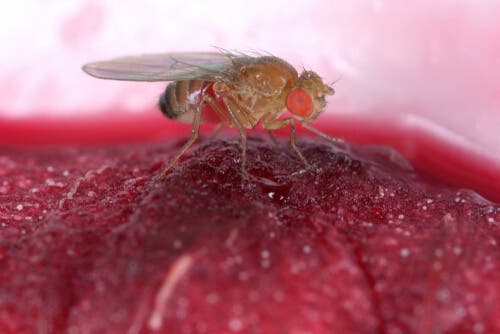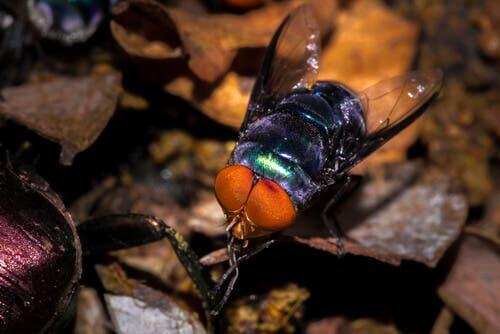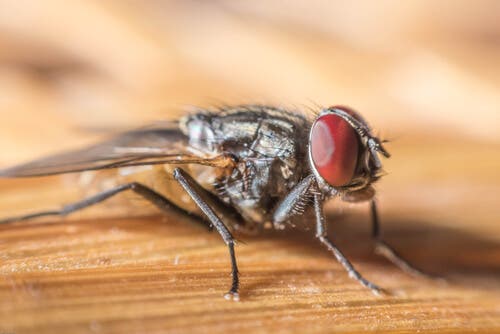Pathogens and Diseases: Can a Fly Be a Disease Carrier?

The answer is yes, a fly can be a disease carrier. They can carry and transfer bacteria, germs, and fungi to surfaces, human bodies, animals, or food. They do this especially with their legs, as they transmit diseases when flying and making stops. In this way, they act as vehicles for pathogens and thus transmitting diseases.
Flies are very attracted to decaying organic matter as it’s the means by which they lay their eggs to reproduce. Biologists that have studied their microbiome estimate that these scavenger insects carry around 800 bacteria on average. Most are harmless to people, but about 100 of them have been shown to cause pathologies with different intensity and severity.
Next, we’ll discuss how a fly can be a disease carrier in more detail. In addition, we’ll analyze some pathologies and how to identify them. We’ll also share some tips on how to control fly presence in our homes and other spaces inhabited by people.
A disease carrier: What pathogens do they transmit?
The common fly usually perches on any dirty surface that has microorganisms that it’s attracted to. Especially carrion, an ideal place for them to leave their eggs and where the larvae can hatch. Flies are also very attracted to feces and all kinds of trash.

Once the insect’s skin has had contact with the dirty surface, it can transfer those microorganisms by perching on human skin, food, utensils, or furniture. Therefore, it’s when the person comes into contact with the fly or ingests food that has been infected by them that she or he runs the risk of acquiring one or more of the diseases that these insects are carriers of:
- Diarrhea in children. In economically-depressed countries, the greatest impact of unhealthiness and fly contagion is experienced by younger children. They suffer from persistent diarrhea, which compromises the lives of children by causing rapid dehydration. This kind of diarrhea is also highly contagious.
- Cholera. This pathology causes watery diarrhea and vomiting, which in turn degenerates into dehydration and fatigue.
- Typhoid fever. This type of fever produces headaches and abdominal pain, high fever, lack of appetite, constipation or diarrhea, and fatigue.
- Dysentery. The most noticeable symptoms of dysentery are diarrhea with mucus and blood, vomiting, abdominal pain, very high fever, headache, and myalgia.
- Salmonella and gastroenteritis. Those affected by either of these ailments can experience abdominal pain, bloody diarrhea, vomiting, headache, fever, and muscle pain.
- Myiasis. An infection that affects the skin, eyes, ears, or other cavities. It can develop into ulcers, pus production, larvae proliferation, and furuncle formations.
Those most at risk are the most vulnerable people in our family such as our children, pregnant women, patients with compromised immunity, and the elderly.
Always consult a professional
When identifying these symptoms, you should visit your doctor as soon as possible. It’s clear that a fly can be a disease carrier and early actions towards treating any potential disease are crucial for a fast recovery and to avoid further complications.
Even though these aren’t the only pathologies that flies can transmit, they’re the most common ones. However, in any case, prevention is always key and can prove to save us and our loved ones a lot of trouble.

How to keep flies under control
The following recommendations can help you to stop the proliferation of these insects or to eradicate them in order to prevent the diseases they are transmitters of:
- Cleanliness of the living spaces. Flies are attracted to dirty, smelly places, and avoid well-lit spaces instead.
- Keeping any trash inside our home well covered. In addition, the trash must be disposed of on a daily basis, especially if it contains any organic waste.
- Use of mosquito nets in doors and windows to prevent insects from entering.
- Controlling the amount of trash around homes and inhabited spaces. In places where public waste collection service is poor, appropriate claims should be made, as it’s considered a public health problem.
- Keeping food well covered. It’s best to not expose food to the environment for a long time. Therefore, refrigerating food is a good option. We should also note that flies use their saliva to dissolve solid meals and eat them.
- Ultraviolet equipment or fumigation. These options do work but have higher economic and environmental costs.
Other homemade tips and tricks
Many homemade tricks are available on the Internet and can help you control flies in your home, but not all of them are very effective. Some examples include hanging transparent plastic bags filled with water, having aromatic plants that flies dislike, spraying vinegar on surfaces, placing garlic, making sweet traps, etc. Therefore, we recommend you try some of these out and choose what works best for your case.
Recommended hygiene measures are sufficient to keep flies away from homes, offices, and other spaces where human activities take place.
A disease carrier agent can certainly become a public health problem, but, in this case, it can’t be completely eliminated. They’re part of the ecological chain and also play an important role in nature. Thus, it’s a matter of us controlling and reducing our waste and improving our living habits to create a healthier life for ourselves and the planet.
All cited sources were thoroughly reviewed by our team to ensure their quality, reliability, currency, and validity. The bibliography of this article was considered reliable and of academic or scientific accuracy.
- Quiceno, J., Bastidas, X., Rojas, D., & Bayona, M. (2010). La mosca doméstica como portador de patógenos microbianos, en cinco cafeterías del norte de Bogotá. Revista UDCA Actualidad & Divulgación Científica, 13(2), 23-29.
- The Center for Food Security & Public Health. (2006). Información sobre vectores: moscas comunes en los Estados Unidos. Recuperado el 5 de julio de 2022, disponible en: https://www.cfsph.iastate.edu/Infection_Control/Routes/Spanish/S_common_flies_US.pdf
